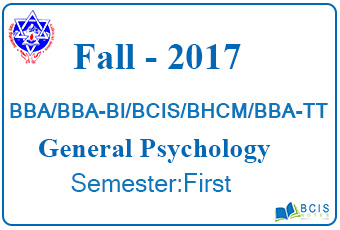
This is the question set along with answers of General Psychology- Fall, 2017, for the first semester which was taken by Pokhara University.
POKHARA UNIVERSITY – General Psychology, Fall 2017
Level: Bachelor Semester: Fall Year:2017
Programme: BBA/BBA-BI/BCIS/BHCM/BBA-TT Full Marks: 100
Course: General Psychology, Fall 2017 Pass Marks: 45
Time: 3 hrs
Section “A”
Attempt ALL the questions.
1. Illustrate the goals of scientific psychology.
2. What are the structures of the brain that control emotion, learning, memory, and motivation?
3. Define a low ball technique?
4. “Perception considered a top-down process”. Justify this statement.
5. How does the sense of taste and smell work?
6. How do you differentiate punishment and negative reinforcement?
7. What does Schachter – the singer’s theory of the emotional state?
8. What is I.Q? How can we calculate it?
9. What are the cognitive factors in stress?
10. Define an Id, Ego, and Superego.
The answers to the above 10 questions
Group “B”
Attempt any SIX questions.
11. What are the different research methods in Psychology? Compare and contrast case studies and surveys. Explain the experimental method in brief.
12. “Neuron plays a vital role in transferring the information from the body to the brain center and brain to body parts.” Explain the different structures and functions of neurons.
13. Explain the Gestalt law of perceptual organization.
14. What is the Parallel Distributed Processing Model of memory? Explain it.
15. Define Social learning theory. Explain its importance in an organization.
16. What are the determinants of intelligence? Why do different individuals have different learning of I.Q?
17. Define personality. Often it is seen that personally is determinants of personality.
Group “C”
Case Analysis
18. Read the following text carefully and answer the questions given below.
Dibya did the first full-time job after the completion of his Bachelors’s as a clerical assistant. He had to take his job to support his further studies. He found work as the clerk very boring and tedious. He had long working hours from 9 am to 5 pm. The work consisted of filing various letters and forms and each day he had to stand for hours in front of a long line of file cabinets. His salary was just Rs.8000/- per month for such long working hours. Later, he discovered that he could finish his work in about two hours and then spend the remaining of the entire workday doing nothing. He learned to work in slow motion turning his brain off so that he could stand there for hours after hours as the clock ticked away the minutes. The only he enjoyed was his lunch and recess breaks. He didn’t quit and studied the job because he needed the money for further education.
In his office, there is another staff working in the same post that is one year senior to his in his college. He rarely reaches office on time and often disappears for many hours during the middle of the day. But he was paid Rs. 10,000/- more than what Dibya has been paid. The difference in salary really insults Dibya. Does the seniority of just one year qualify him for a higher salary? How can I also get the same perks? He then found out that he is a son of a politician and so now concludes that his larger salary reflects the fact that his father is someone powerful. This fact made Dibya lose any motivation to perform better in the job.
One morning Mandy waited for the light to change so that she could cross the street school. As the light in her direction turned green, she stepped off the curb. Suddenly Mandy froze as a car shot right past her through the red light and crashed into already in the intersection. Mandy was not hurt. The car that went through the red light was not that close to her, but she felt terrified, then weak and shaky. She was so upset that she started to cry. That moment at school, whenever Mandy thought about the accident she had been she felt nervous and shaky. By lunchtime when she talked to her friends about the accident, she showed off that she had been brave enough to face the situation when ease, though she has still got a shaky feeling. She was beginning to get angry towards the driver of the car that had run the red light. Although Mandy was not physically hurt, her mind and body were experiencing a strong emotional reaction to a dangerous situation at the whole day she found herself being lost in the same accident and she ended up leaving her school for her home before her class got finished.
Questions:
a. Make the distinction between felt emotions and displayed emotions; illustrate it with an example of Mandy.
b. What are the implications of emotions in an organization?
c. Illustrate the factors affecting work motivation?
d. Explain the type of motivation depicted in Dibya’s case. What would you do as the manager to address the above situation?
You may also like Pokhara University || Fall,2014 || Introductory Microeconomics

Leave a Reply